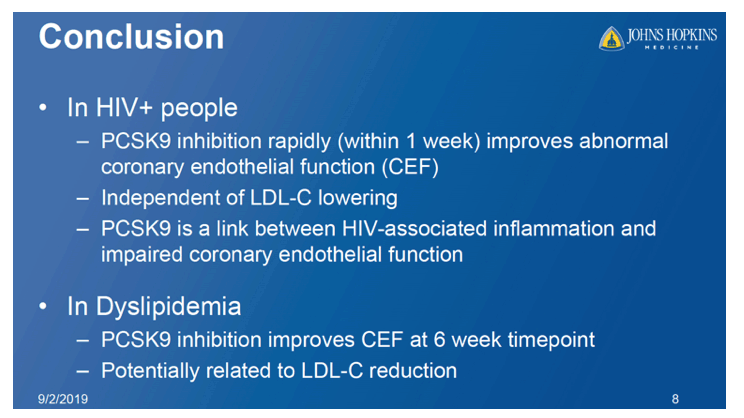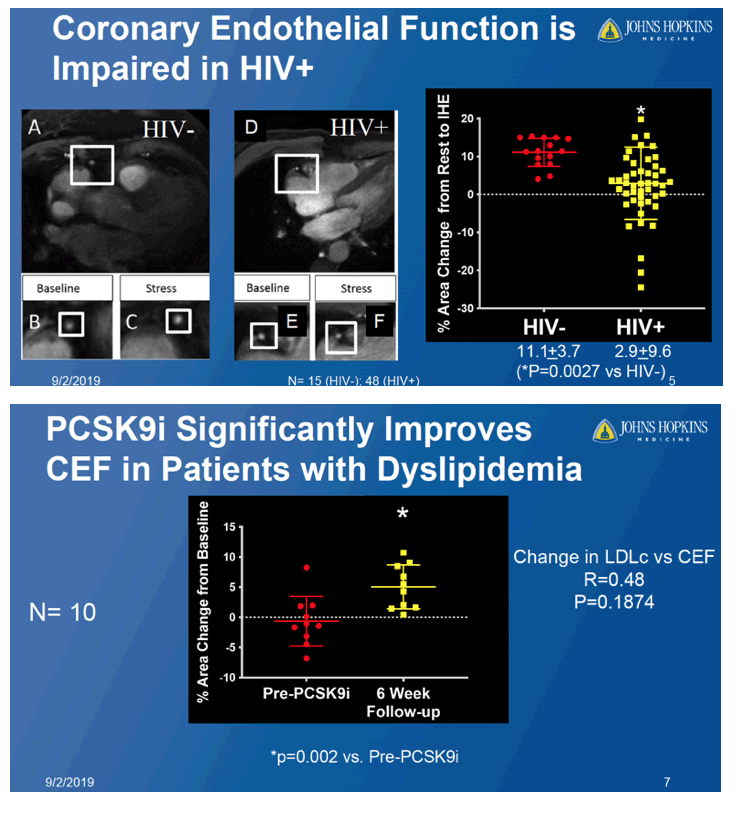| |
Evolocumab rapidly reverses impaired coronary endothelial function in six weeks in people living with HIV and in patients with dyslipidemia
|
| |
| |
Download the PDF here
is this better than a statin ? Jules
Session: Influence of metabolic or infection disease on the heart
Topic: HIV and Cardiovascular Disease
Speaker: Assistant Professor T. Leucker (Baltimore, US)
Authors:
T. Leucker 1 , G. Gerstenblith 1 , M. Schar 1 , T. Brown 1 , S. Jones 1 , R. Weiss 1 , A. Hays 1 , 1 Johns Hopkins University - Baltimore - United States of America ,
Citation:
European Heart Journal ( 2019 ) 40 ( Supplement ), 2560
Background/Introduction: Proprotein convertase subtilisin/kexin type 9 (PCSK9) is well recognized for its importance in cholesterol metabolism. Elevated levels are associated with increased cardiovascular risk and inhibition with PCSK9 antibodies lowers cardiovascular events in patients with known coronary disease. PCSK9 levels are also elevated in people living with HIV (PLWH), and we previously reported that increased PCSK9 in PLWH is associated with impaired coronary endothelial function (CEF), a major driver for the development, progression, and clinical manifestations of coronary artery disease.
Purpose: Here we investigate the hypothesis that PCSK9 inhibition improves impaired CEF in PLWH and in patients with dyslipidemia (DL).
Methods: Cine 3T MRI was used to noninvasively measure CEF, assessed as the change in coronary cross-sectional area (CSA) from rest to isometric handgrip exercise (IHE), a known endothelial-dependent vasodilator. Eight HIV+ subjects on stable highly active antiretroviral therapy and with undetectable HIV RNA (mean age 53±9 yrs, LDLC 98±18 mg/dL, 38% on statins) and ten patients with dyslipidemia (DL) without HIV receiving evolocumab for clinical reasons (mean age 56±10 yrs, LDLC 130±28 mg/dL, 50% on statins) underwent MRI studies before and six weeks following the initiation of evolocumab 420 mg. MRI readers were blinded to group and timepoint. MRI data are presented as mean±SD for % change rest vs IHE.
Results: Prior to evolucumab, resting CSA in the two groups did not differ and IHE did not induce normal coronary vasodilation in either group; mean stress-induced CSA changes were -2.1±6.4% in HIV (p=0.27) and -0.6±4.1% in DL (p=0.46). Notably, CEF significantly improved following six weeks of evolocumab with IHE-induced CSA changes of 7.6±5.7% (p=0.006) and 5.0±3.6% (p=0.002) in the HIV and DL groups, respectively. The %-LDLC reduction with evolocumab was profound and comparable in the HIV and DL groups, 73±5% and 60±6% (p=0.19 HIV vs. DL). There was no significant correlation between the extents of LDLC reduction and of CEF improvement in either of these modest sized groups.
Conclusion: PCSK9 inhibition with evolocumab significantly improves abnormal coronary endothelial function after only six weeks in HIV+ people with normal LDLC and in HIV- people with DL. To our knowledge, these data represent the earliest (6 weeks) evidence for improvement in human coronary artery health by PCSK9 inhibition.


|
|
| |
| |
|
|
|